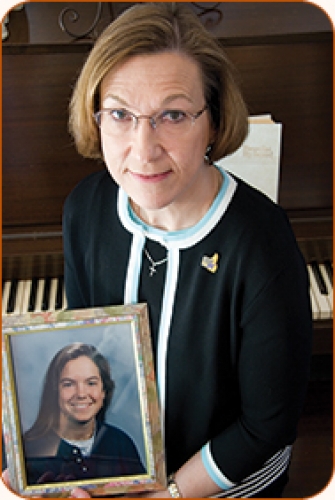Inside Lauren Brown’s head, a voice was scolding her. “You aren’t good enough for that food,” it said. “Why should you have it when there are children starving in this world?”

Photo: Jason Smith
“No one would ever wish this on their very worst enemy,” says Diane Brown. She holds a photo of her daughter, taken before Lauren developed anorexia. Photo: Jason Smith

Click to read photo caption. Photo: Jason Smith
Her parents were worried. She started losing weight at the end of her sophomore year of high school, when she was on the basketball team. “Oh, I’m just eating healthy,” she’d said. “You know, fresh fruits and vegetables, low fat.” She trained harder and harder, and shed pounds rapidly. By spring of her junior year, Lauren hadn’t had a period in four months.
“There’s a choice when it comes to going on your first diet,” says Cynthia Bulik. “Just like there’s a choice when someone takes their first cigarette or when they have their first drink. After a certain point, though, it’s no longer a choice.”
People genetically predisposed to anorexia nervosa are biologically different, Bulik says. While most of us get grumpy or distracted when we haven’t eaten, food deprivation has a calming effect on some people. They generally like that feeling, and while environmental factors may cause someone to go on their first diet, their biological response will keep them at it.
In March, Bulik and her colleagues from UNC and around the world found that about 56 percent of the liability for developing anorexia rests in the genes, while environmental factors account for 44 percent.
Bulik’s team collaborated with the Karolinska Institute in Sweden to collect data from 31,406 individuals in the Swedish Twin Registry, the largest twin registry in the world. After linking registry data to death, birth, and hospital records, the team found that both members of the identical twin pairs (who are genetic duplicates) had anorexia nervosa more frequently than did both members of the fraternal twin pairs (who are genetically distinct).
What’s more, Bulik and another research team have identified a hotspot for anorexia nervosa on the genome, which means they’re closer to determining which genes affect one’s likelihood of developing anorexia. The human genome has about thirty thousand genes; this study led the team to focus their search on a specific area on Chromosome 1.
“We don’t know a lot about the biology of anorexia,” Bulik says. “But if we can go backwards from identifying genes to having the genes tell us something about the neurobiology, we might be able to develop a medication that works for this disorder. Right now, we have no medications that are effective in treating anorexia nervosa.”
As a child, Lauren was gentle, caring, a devout Christian, and had a shy but razor-sharp sense of humor. “And she described herself as definitely not a girly-girl,” says Diane, Lauren’s mother.
The summer after her junior year of high school, Lauren went to Houston to do volunteer work with inner-city Hispanic kids. When she got home, her parents saw that even though she’d gained five pounds, she hadn’t had a period in six months and still looked disturbingly underweight. They took her to a pediatric endocrinologist.
“Lauren is fine,” the doctor told Diane as Lauren listened. “She has no problem. You are her problem. If she wanted to, she could even lose those pounds she gained in Houston.”
“We were ignorant at the time,” Diane says. “We trusted the doctor. But he empowered the eating disorder. I know now that he shouldn’t even have made a diagnosis like that. He did not have the training. We lost two valuable years of treatment because of it.”
A month later, Lauren turned eighteen, and her parents no longer had access to any of her medical or treatment records, nor were her doctors allowed to speak with them about her condition. Embarrassed and terrified that the stigma of an eating disorder might ruin her medical career aspirations, she swore her family to secrecy about the problem. “For over ten years, we all suffered in silence,” Diane says. “She adamantly demanded that we not tell a living soul.”
“Anorexia often has a very secretive component,” Bulik says. It can be devastating for parents who don’t get support from professionals and from other parents going through the same struggle.
A childhood tendency that Bulik calls neuroticism may be an indicator for parents, doctors, and teachers to screen for children who are genetically predisposed to anorexia before they become sick.
“These kids are emotional Velcro,” Bulik says. Troubles that roll off other children’s backs really stick to them, and sometimes so subtly that their parents can’t tell. They tend to be well behaved and smart, but anxious and depressed, often about things over which they have no control—a dead animal in the road, for instance.
Throughout college, Lauren sought treatment sporadically, only when it didn’t interfere with her studies. She sparkled academically and graduated a semester early from Georgia Tech. Then it was off to med school at Carolina. Before her classes started, she went for treatment regularly and made some progress. Her therapist told Lauren’s parents that they could maintain that progress by keeping in touch through e-mail and phone calls. “That was our plan,” Diane says. “Well, by the spring it was pretty obvious that plan wasn’t working. Lauren’s therapist called my husband one night about something, an insurance issue maybe.”
“How do you think she’s doing?” asked Lauren’s father desperately.
“How do you think she’s doing?” the therapist responded.
“Not well at all,” he said.
“I agree.”
“Lauren would never have gone to treatment at Carolina because she knew people there,” Diane says. So the summer after her first year of medical school, Lauren’s parents decided to take her to Remuda Ranch for residential care. Lauren was angry and hurt, and she fought them at first. The night before they were to leave, Lauren’s parents thought she might refuse to go. “It came to the point where I had to accept the fact that if I forced her, my only child might never speak to me again,” Diane says. In the end, though, Lauren stayed at the treatment center in the Arizona desert for seven weeks. “Her body weight was so low that they wouldn’t even let her walk between buildings,” Diane says. “She rode in golf carts.”
Lauren resisted treatment, and itched to get back to school. “That summer was the most difficult time of our lives,” Diane says. “But I think Remuda Ranch extended her life a couple of years.”
Back when Bulik entered the field of eating disorders research in 1982, anorexia nervosa was still considered to be a frivolous disease of choice. Girls want to be skinny, society said, and they go overboard when their parents are too strict. “It’s the same misperception we’ve seen with schizophrenia,” Bulik says. “People thought it was unhealthy parenting that caused it. We went through it with autism, where mothers were blamed for being cold and not bonding with their children. Now, decades later, it’s clear that these are biological disorders. We are now seeing the exact same transformation with anorexia nervosa.
“These parents are some of the most loving and caring parents you’ll ever meet. They want to help. I’ve got three children, and there is nothing in the parental playbook that tells you what to do when your child stops eating.”
Back in medical school, Lauren learned how to keep herself alive. She became expert at keeping her electrolytes up while still refusing food.
One month before she was to finish her third year at Carolina, Lauren came down with a virus. “She was so sick by then that she finally agreed to take a medical leave,” Diane says. It was the beginning of June, and the family took a trip to the beach. “She was so emaciated by then that people pointed and nudged others to look,” Diane says. Lauren’s father refused to take photographs on that trip.
“If your child comes to you and they’re a normal weight and they say they’re going on a diet,” Bulik says, “you should take that as seriously as if your child was to say, ‘Mom, I’m going to have my first cigarette today,’ or ‘I’m going to have a beer with dinner tonight.’ The red flags need to go up.” Screening your children for budding symptoms, she says, may save your family years of heartache. “I say this to families all the time. If you have a mom or a grandmother who has diabetes, even if you’re clean, you’re always on the lookout for signs of diabetes in your children. Because you’ve got a family history, and you’re vigilant about it. Why should it be any different with eating disorders?”
For people with certain wiring, Bulik says, “biology takes on a life of its own. The train just starts running.”
Diane nods her head firmly and says, her voice shaking, “Lauren died in her sleep on a Thursday.” It was August 2003. Lauren was 25 years old.
“To this day, we don’t know how much Lauren weighed when she died,” Diane says. “But I can guarantee you I wouldn’t want to know. We saw how she looked.
“Lauren was suffering so much. As much as I miss her and wish she were here, I know she she’s not suffering now. Lauren was a strong Christian, and we know she’s safe and well in Heaven. We know we’ll see her again one day. And that’s a wonderful thing to be sure of.”
Two months after Lauren’s death, when Diane was speaking about her daughter at an eating disorders forum, she met and made friends with Cynthia Bulik. And years later, when Bulik called Diane with the results of her study, the two celebrated. They were ecstatic, Diane says, because the general public just doesn’t know about the biological component of the disorder.

Image: Scala/Art Resource, NY
St. Catherine of Siena died of anorexia in 1380.Image: Scala/Art Resource, NY

Click to read photo caption. Image: Scala/Art Resource, NY
Anorexia nervosa, Bulik says, does not just happen to adolescent white girls. It occurs in men, African Americans, older women, children. The stereotypes have only set patients back, she says. What doctors have called a teenagers’ disease could be anyone’s—because, Diane says, “it is a disease; it’s not a choice.”





